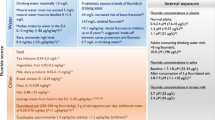Abstract
The effect of defined lead burdens on myelination of the central and peripheral nervous systems was studied in neonatal Long-Evans rats. Pups were exposed to inorganic lead (100 or 400 mg Pb as lead acetate/kg body wt/day by gastric intubation) from day 2 following birth to 30 days of age. Accumulation of myelin in forebrain was not affected by the 100-mg dosage, but at the 400 mg/kg dosage level, myelin accumulation was reduced by approximately 42% on a per gram forebrain basis relative to vehicle-intubated animals. The deficit was over 50% on a per forebrain basis, since there was also a slight reduction in brain weight. This lead effect was observed at both 15 and 30 days of age. Accumulation of myelin in optic nerve (determined on the basis of proteolipid protein concentration) was also reduced by 30% relative to controls by this dosage level. However, myelination in sciatic nerve (determined on the basis of P0 protein concentration) was not affected by this exposure regimen. Myelin deficits were greater than could be accounted for by undernutrition arising secondary to lead exposure and were not due to a developmental delay in the onset of myelination.
Similar content being viewed by others
References
Adams, D. H., andOsborne, J. 1973. A developmental study of the relationship between the protein components of rat CNS myelin. Neurobiology 3:91–112.
Banik, N. L., andSmith, M. E. 1977. Protein determinants of myelination in different regions of developing rat central nervous system. Biochem. J. 162:247–255.
Brashear, C. W., Kopp, V. J., andKrigman, M. R. 1978. Effect of lead on the developing peripheral nervous system. J. Neuropathol. Exp. Neurol. 37:414–425.
Drummond, G. I., Eng, D. Y., andMcIntosh, C. A. 1971. Ribonucleoside 2′,3′-cyclic phosphate diesterase activity and cerebroside levels in vertebrate and invertebrate nerve. Brain Res. 28:153–163.
Ediger, R. D., andColeman, R. L. 1972. Modified Delves cup atomic absorption procedures for the determination of lead in blood. Atomic Absorp. Newslett. 11:33.
Grant, L. D., Breese, G., Howard, J. L., Krigman, M. R., andMushak, P., 1976. Neurobiology of lead-intoxication in the developing rat. Fed. Proc. 35:503.
Greenfield, S., Brostoff, S., Eylar, E. H., andMorell, P. 1973. Protein composition of the peripheral nervous system. J. Neurochem. 20:1207–1216.
Greenfield, S., Norton, W. T., andMorell, P. 1971. Quaking mouse: Isolation and characterization of myelin protein. J. Neurochem. 18:2119–2128.
Jones, D. H., andMatus, A. I. 1975. Changes in protein content of developing brain synaptic membranes, mitochondria and myelin. Neurosci. Lett. 1:153–158.
Kolber, A. R., Krigman, M. R. andMorell, P. 1980. The effect of in vitro and in vivo lead intoxication on monosaccharide transport in isolated rat brain microvessels. Brain Res. (in press).
Konat, G., Offner, H., andClausen, J. 1976. Triethyllead-restrained myelin deposition and protein synthesis in the developing rat forebrain. Exp. Neurol. 52:58–65.
Krigman, M. R., andHogan, E. L. 1974. Effect of lead intoxication on the postnatal growth of the rat nervous system. Environ. Health Perspec. 11:187–199.
Krigman, M. R., andHogan, E. L. 1976. Undernutrition in the developing rat: Effect upon myelination. Brain Res. 107:239–255.
Krigman, M. R., Druse, M. J., Taylor, T. D., Wilson, M. H., Newell, L. R., andHogan, E. L. 1974. Lead encephalopathy in the developing rat: Effect upon myelination. J. Neuropathol. Exp. Neurol. 33:58–73.
Krigman, M. R., Traylor, D. T., Hogan, E. L., andMushak, P. 1974. Subcellular distribution of lead in the brains of intoxicated and control rats. J. Neuropathol. Exp. Neurol. 33:562 (abstract).
Krigman, M. R., Mushak, P., andBouldin, T. W. 1978. An appraisal of rodent models of lead encephalopathy. Pages 299–302,in Roizin, L., Shiraki, H. andGrcevic, N. (eds.), Neurotoxicology, Vol. I, Raven Press, New York.
Kurihara, T., Nussbaum, J. L., andMandel, P. 1971. 2′,3′-Cyclic nucleotide 3′-phosphohydrolase in purified myelin from brain of jimpy and normal young mice. Life Sci. 10(2):421–429.
Lowry, O. H., Rosebrough, N. J., Farr, A. L., andRandall, R. J. 1951. Protein measurement with the Folin phenol reagent. J. Biol. Chem. 193:265–275.
Maizel, J. V., Jr., 1971. Polyacrylamide gel electrophoresis of viral proteins. Methods Virol. 5:179–246.
Morell, P., Greenfield, S., Constantinio-Ceccarini, E., andWisniewski, H. 1972. Changes in the protein composition of mouse brain myelin during development. J. Neurochem. 19:2545–2554.
Norton, W. T., andPoduslo, S. E. 1973. Myelination in rat brain: Method of myelin isolation. J. Neurochem. 21:749–757.
Norton, W. T., andPoduslo, S. E. 1973. Myelin in rat brain: Changes in myelin composition during brain maturation. J. Neurochem. 21:759–773.
Stowe, H. D., Goyer, R. A., Krigman, M. R., Wilson, M. H., andCares, M. 1973. Experimental oral lead toxicity in young dogs: Clinical and morphological effects. Arch. Pathol. 95:106–116.
Tennekoon, G., Aitchison, C. S., Frangia, J., Price, D. L., andGoldberg, A. M. 1979. Chronic lead intoxication: Effects on developing optic nerve. Ann. Neurol. 5:558–564.
Toews, A. D., Horrocks, L. A., andKing, J. S. 1976. Simultaneous isolation of purified microsomal and myelin fractions from rat spinal cord. J. Neurochem. 27:25–31.
Toews, A. D., Kolber, A. R., Hayward, J., Krigman, M. R., andMorell, P. 1978. Experimental lead encephalopathy in the suckling rat: Concentration of lead in subcellular fractions enriched in brain capillaries. Brain Res. 147:131–138.
Wiggins, R. C., Benjamins, J. A., andMorell, P. 1975. Appearance of myelin proteins in rat sciatic nerve during development. Brain Res. 89:99–106.
Wiggins, R. C., Miller, S. L., Benjamins, J. A., Krigman, M. R., andMorell, P. 1976. Myelin synthesis during postnatal nutritional deprivation and subsequent rehabilitation. Brain Res. 107:257–273.
Zgorzalewicz, B., Neuhoff, V., andWaehneldt, T. V. 1974. Rat myelin proteins. Compositional changes in various regions of the nervous system during ontogenetic development. Neurobiology 4:265–276.
Author information
Authors and Affiliations
Rights and permissions
About this article
Cite this article
Toews, A.D., Krigman, M.R., Thomas, D.J. et al. Effect of inorganic lead exposure on myelination in the rat. Neurochem Res 5, 605–616 (1980). https://doi.org/10.1007/BF00964782
Accepted:
Issue Date:
DOI: https://doi.org/10.1007/BF00964782




